Level of surfing
Advanced
Quality of surf
Very Good
Call code
63
Net code
ph
Area
300000
Coastline
0 km
Climate
Hazards
Cyclones, Difficult Access, Coup / Civil Unrest
Best Months
July - October
Population
88706300
Currency
Peso (PHP)
Time Zone
PST (UTC+8)
Special Requirements
Private Beaches, Special Pass / Permits, Strict Religious Observance
introduction

Eugene Villar: Provinces of the Phillipines; 2003
Nestled in the south China Sea lies the Archipelagic nation of the Phillipinnes, a nation of 7107 islands. Only a small area of the Philippines has been adequately mapped by surfers – untold riches await the brave. Surf camps are beginning to pop up all around the country and hopefully will lead to the discovery of new spots. With over thirty six thousand kilometres of coastline, chances are that there is another Cloud 9 out there.
But, take caution young traveller. The remote areas of the Philippines have been home to pirates for centuries; even today yachts and merchantmen are regularly boarded and robbed. The southern areas of Mindanao are a wilderness and are known to be a training ground for several terrorist cells. If you happen to be in the area, take the appropriate precautions.
history
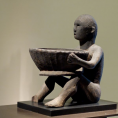
Jastrow: Bulul guardian figure of the Ifugao people c.15th century: 2006
Waves of early humans settled the area known as the Philippines from about 50,000BC including Austro-Melanesians and Malayo-Polynesians. The land developed a rich and unique culture with flourishing trade routes established with India, China and Islamic nations by 900AD. The famous Portuguese explorer Ferdinand Magellan arrived in 1521 but it was the Spanish who were to colonise the region from 1565. Having said this, there were remote mountainous areas in the highlands that had never seen a white European until the 1900’s.
Spain was to eventually lose all of her colonies in the area which included Cuba and Puerto Rico following their defeat in the Spanish-American war. A turbulent 45 years were to follow with occupying US forces fighting sporadically with Phillipino rebels over the administration of the region. Japan occupied the islands briefly during World War II before the country was granted its independence from the United States in 1946.
Corruption and infighting was to plague the various government structures right up to the current day. These factors combined with a near exponential population growth will continue to present challenges for the Philippino people into the future.
surfing

Johnycanal: Phuka Beach, Philippines; 2006
A pitching deck, the creak of well worn timbers, the cracking of sail and canvas...tied to the mast. Things have changed a little I guess from when Jack London and Josef Conrad wrote their haunting Pacific infused epics but it hasn’t changed everywhere. There are corners of this earth where that myths still holds true, and most of those corners are here in the South Pacific.
The main source of swell here is from the intense lows that circle the earth south of Australia, these lows spin off northwards with blessed regularity, peppering the entire region with generous SE to SW groundswell from March to September. Australia and New Zealand see the bulk of these swells. These countries cast a very tall shadow across the rest of the Pacific and hence many other islands in their wake can suffer from swell diffusion. December to February is cyclone season. Unpredictable cells can deliver swell in a 360 radius, lighting up rarely breaking reefs and points facing every conceivable direction.
The South Pacific trade winds are some of the most consistent in the world, generally from the East with slight seasonal variation. This is the largest Ocean on the planet and these winds easily generate regular rideable swell. Onshore conditions can be a problem on east facing coastlines but peeling yourself out for early surf will usually bring some relief.
In the North Pacific it is the intense lows descending from the Aleutians that deliver NE to NW swells from October to March. Hawaii is ideally placed to make best use of this energy but other coastlines in the region have their own less publicised and far less crowded gems.
June to October also sees rarer hurricane swell radiate out from southern Mexico. This energy is often felt right throughout Polynesia. With so many energy vectors at work it is very hard not to find a wave in the Philippines. It's just a matter of finding the right one.
The islands have absolutely no shortage of points, reefs and beach breaks. This area of the South China Sea / West Pacific can be notoriously fickle as far as regular swell generating weather systems go. Your surfing will generally be restricted to the monsoon seasons. The good news is that the Philippines has 2 of them.
The North East monsoon (November to April) can produce quality swell that lights up the eastern breaks, including Cloud 9. Larger cells can wrap around the northern tip of Luzon though the Babuzan Island chain to the north attenuates much of this. The South West monsoon (May to October) can generate sufficient swell to break on the north west coast of Luzon and there are several good breaks here. Further south the west coast is limited due to the close proximity of Borneo and other large island masses.
travel
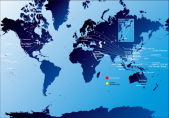
Nino Lorenz08: Philippines Airlines International Destinations; 2006
Flying is the most common method of arrival into the country, you will probably fly into Manilla initially and the named breaks to the North West are only around 2-3 hours drive from Manilla. If you are heading for Cloud 9 and the other more consistent east coast breaks then you will be looking to catch a connecting flight to one of the southern cities. Obly a small patch of this coastline has been explored by surfers and to be honest it is remarkable that Cloud 9 was even discovered.
Even today it can be notorious to locate and many a surfer has spent a week at a very good reef nearby only to eventually discover that they weren’t actually surfing Cloud 9 at all – if anything it certain demonstrates the potential of the coastline. Back to Cloud 9 – best bet is to grab a connecting flight from Manilla to Surigao City (Surigao Island) and then get a bus / car to Taganito. You can get a ferry from here to Dapa which is on the same islet that Cloud 9 is on (Siargao).
Alternatively you could fly into Siargao Island via a few flight connections. Head over to the east coast to the town of General Luna which is only a few miles from the break. There are a few other good waves in the area as well such as Jacking Horse and Pacifico just a short paddle away.
weather
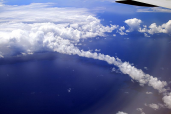
Mila Zinkova: Clouds above the Pacific: 2007
The Philippines are located in the tropics, between the latitudes of 4 and 21°N. Therefore the weather is usually hot and humid, typical of the tropical monsoonal climate that is defined by two distinct seasons: dry season (northeast monsoon) and wet season (southwest monsoon). The main influences are the strength and position of the Asiatic high; a semi-permanent, subtropical area of high-pressure over the Asian continent, and the monsoon trough (trade wind convergence). The Northeast monsoon extends from November to April and is dominated by the trade winds, which bring clear skies and sunshine for most of the islands during the period. The southwest monsoon runs from May to October and is dominated by the monsoon trough causing frequent rain and the threat of typhoons. In fact the northern Philippines has the highest frequency of tropical storms and typhoons in the world. The season extends from May through December and the frequency is highest during August and September. The Philippines has been referred to at times as the Fickle-ppines, due to its reliance on typhoon-generated swells for the best waves, but has some of the best barrels the world. Tropical depressions and typhoons forming over the western Pacific (south and east of Japan) provide the best quality swells during the wet season.
Northeast Monsoon (November-April)
During northeast monsoon the Asiatic high reaches its peak strength pushing warm stable air mass towards the islands. The monsoon trough is south of the Philippines during this season, so the Philippines are subject to the north-easterly winds throughout the season. Rainfall at this time of year occurs mainly on the east (windward) coasts, which have rain more than 10-13 days per month. In general, rainfall days decrease from east to west across the islands, and the west coasts receive less than 4 days of rain per month. Pacific Ocean typhoons are still a threat in November and December, and possible swell source. This time of year tends to be the coolest, particularly in the north and east. However you won’t be reaching for jackets with mean high temperatures range from 27 to 31°C across the islands. The eastern coasts are at the cooler end due to cooling of the trade winds. Average lows range from 21 to 25°C.
Southwest Monsoon (May-October)
The position of the monsoon trough affects the weather over the Philippines during this season. When it is south of the area, the trade winds prevailing and fair weather occurs. This happens early in the season, before the monsoon trough begins to move northward across the Philippines. As this happens a band of unstable weather with showers and thunderstorms hit the archipelago. South of the trough, the southwest monsoon transports unstable equatorial air mass that causes cloudy weather with rain along the west coasts. Tropical cyclones occur most frequently during this season and reach peak occurrence in August and September. The average tracks of these storms cross Luzon during July to September. They can be dangerously destructive but also provide epic swells, depending in their location and track. Mean winds are from the southwest, so combine swell from a Typhoon and offshore winds and the Siargao islands can turn it on including the famed Cloud 9. The southwest monsoon season is considered the rainy season, but only the western Philippines experiences rain at this time of year. During this season, the number of rainy days varies between 15 and 20 days per month along the west coast, while the east coast has 5 to 10 days. Although temperatures are fairly constant year-round in the Philippines, they peak in April to June. During the southwest monsoon, the average temperature ranges between 28 and 34°C. Average lows are also fairly uniform between 24 and 26°C throughout.
where to stay
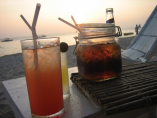
Johnycanal: Happy Hour on White Beach, Niggi Niggi's Philippines; 2006
If you are looking to surf the Cloud 9 area, the top of the range is the Pansukian Resort – great access to the rest of the breaks on the island also. Rooms start at around $150 USD p/p p/n. There are plenty of well priced alternatives on the island and throughout the country if this is a little outside your budget.
what to pack
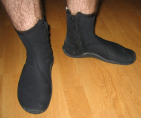
Douglas Whitaker: wetsuit booties: 2006
You will be passing through one of the major cities of the Philippines prior to heading for the typically more remote surf coasts so don’t worry too much about bringing a lot of consumable gear with you. Do stock up prior to heading to the coast however as supplies can be sporadic, particularly during the wet season. Cases of Malaria are infrequent in the Philippines but not unheard off and hence anti malarial's are a solid insurance policy.
Be sure to pack your reef booties - this particular item can be very hard to locate in country. There are plenty of diving booties available but unless you like the feeling of trying to surf in clown shoes you may want to bring your own.
dangers and warnings

The artful dodger: A pictorial history of Australia; 1790
Manilla is a relatively safe city, the major problem being pickpockets and petty thieves common to South East Asia. If you take the usual precautions of avoiding flashing around large sums of cash and electronic gadgetry you should be fine. some parts of the southern Philippines especially down towards Zamboanga are experiencing ongoing internal strife. Terrorist training camps have been reported in the area and generally there will be warnings regarding the passage of western tourists.
If you are coming to the Philippines for the diving and surfing this is unlikely to affect you but should you be travelling further afield be sure to exercise due caution, a local guide should be your first investment.
shopping and nightlife
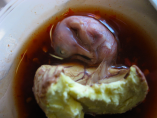
Sspitzer2: 15 Day Balut Egg; 2007
The Philippines would easily be the most affordable country to travel in the whole of South East Asia. You won't find much in the way of traditional art and craft in the cities but the outer towns offer excellent wood and stone carvings. Like many Asian countries, viewpoints on which parts of an animal is considered fine dining are a little different to what you may be used to. Be a little adventurous and you may discover a rare treat. Some local delicacies include:
Puto - a general term for rice cake, they usually come as soft white rice muffins or pie-shaped desserts. Other kinds include Biko, Cuchinta, Pichi-Pichi, Sapin-Sapin, etc. The town of Calasiao in Pangasinan is famous for its puto.
Dinuguan - a dark stew of pig's blood mixed with its innards. Usually served with a big green chilli and best eaten with puto
Bopis - pork innards, usually served spicy
Balut - is a fertilized duck egg with a nearly-developed embryo inside that is boiled and eaten in the shell. Popularly believed to be an aphrodisiac and considered a high-protein, hearty snack, baluts are mostly sold by street vendors at night in the regions where they are available. Boiled and usually eaten with a sprinkle of salt and vinegar.
Enjoy!
what to do when it's flat
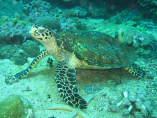
Hawksbill Turtle, Sabang, Philippines; 2006
The Philippines offers some of the best diving in the world. The living reef's off the East coast provide shelter for an extraordinary amount of marine species, many found nowhere else in the world. Problems with over fishing and poaching on the reef systems are slowly being improved via education on sustainable fishing and tourism. hopefully with these schemes in place, the diving industry in the Philippines will be around for many years to come.
useful phrase guide

Official languages in Philippines are Filipino and English. Recognised regional languages are Tagalog, Bikol, Cebuano, Ilocano, Hiligaynon, Kapampangan, Pangasinan and Waray-Waray.
Here are some useful phrases in Filipino:
Kumusta? - How are you? This is the usual Filipino greeting. Respond by saying "mabuti."
Magandang umaga/hapon/gabi. - Good morning/afternoon/evening.
Mabuhay! - Long live! This is used as a greeting or as a cheer. Probably related to the spanish "viva".
Paalam - goodbye. Paalam is a bit formal though, sometimes used for dramatic effect. Normally people just say "sige", the meaning of which is closer to "alright then".
Anong pangalan mo? - What is your name? Some people say "Sino ka?" (who are you) but it is generally considered impolite.
Ang pangalan ko ay X. - My name is X. You can also say "Ako si X" - I am X.






